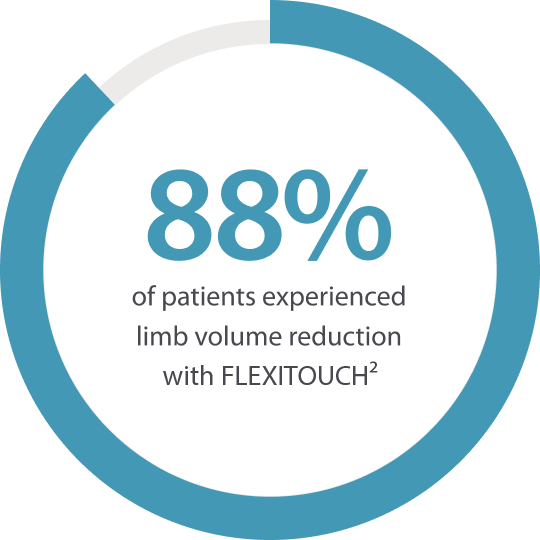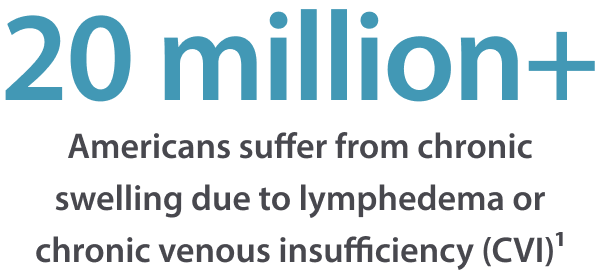Lower Extremity Lymphedema Treatment
Find Relief at Home with the Flexitouch® Plus or Nimbl™ systems
Enjoy targeted relief from swelling and related lymphedema symptoms with pneumatic compression devices like the Nimbl™ or Flexitouch® Plus system. These lymphedema pumps are designed to be used once an hour each day to encourage the flow of fluid to reduce chronic swelling, helping patients enjoy a better quality of life. Paired with lymphedema garments like compression socks and sleeves that can be worn daily, Nimbl and Flexitouch Plus systems are excellent for symptom management.
Flexitouch Plus provides a comfortable, effective, at-home treatment designed to help head and neck lymphedema patients get back to their lives.

The Flexitouch Plus system moves lymph fluid to reduce swelling. It is clinically proven to stimulate the lymphatic system, enhance quality of life and reduce episodes of cellulitis.
Flexitouch Plus helps patients self-manage their lymphedema, chronic venous insufficiency (CVI) and nonhealing
venous leg ulcers with:
Clinically Proven: Clinical evidence shows that Flexitouch is proven to work better than self-manual lymphatic drainage (MLD), basic pumps or standard therapy with self-care alone.
Consistent: High patient satisfaction encourages ongoing use and better outcomes.
Comfortable: Garments are made of soft, comfortable fabric.
Convenient: Garments are designed for ease of use, and even the ability to treat both legs at the same time.
Discover
Nimbl™
for Lower Body
Innovative and effective basic pneumatic compression therapy, with a small, light, and compact controller designed for an improved patient experience.
Discover
Flexitouch® Plus
for Lower Body
Empowering patients to self-manage their lymphedema, venous insufficiency and nonhealing venous leg ulcers from home helps improve outcomes and quality of life.4, 5
Discover
Entre® Plus
for Lower Body
A simple and convenient solution to help patients reduce swelling and gain mobility and dexterity — often serving as a required first step for some insurance providers.

Lymphedema can be debilitating and can lead to serious skin infections and wounds.
Chronic swelling in the lower body can be a challenge to diagnose because there are many potential causes. If the cause is lymphedema, it can also be difficult to manage because there currently is no “simple fix,” such as a pill to take. In the absence of appropriate treatment, lymphedema can cause skin infections, like cellulitis, permanent internal scarring (fibrosis) and other serious skin changes or wounds.
As with any chronic, progressive condition, early intervention and practical tools for daily management create the best results.
Discover Our Solutions
No matter where you may have swelling, we can help.
In many cases, the sooner you treat chronic swelling, the better for your long-term health. Our at-home therapy is designed to treat your swelling on your own time to help you get back to living your best life.
Upcoming webinars
Register for our upcoming live webinars or take a look at past webinars and other resources for the latest research
Need help now? We’re here for you.
Call us at 1.833.3TACTILE (1-833-382-2845)
Lower Body Lymphedema FAQs
What is lower body lymphedema?
Lymphedema in the lower body, such as the legs, groin, abdomen, or trunk, is a chronic, progressive condition caused by an abnormal accumulation of fluid that results in localized swelling. Lymphedema in the lower body can be classified as primary lymphedema, where the condition is inherited, present at birth, or spontaneous in nature. However, lower body lymphedema is more commonly the result of a disruption to the lymphatic system, known as secondary lymphedema. Cancer, cancer surgery, radiation therapy, blood clots, chronic venous insufficiency, infections like cellulitis, and trauma from an injury like a crushing accident or burn are some of the causes of lymphedema in the legs. While lymphedema is a chronic and progressive condition, there are ways to manage swelling, pain, and related symptoms, such as lymphedema compression garments, lymphedema pumps that deliver pneumatic compression, exercise, and lifestyle modifications.
What are the symptoms of lymphedema in the legs?
Lymphedema is a chronic and progressive condition, which means symptoms may start out mild and progress in severity if treatment and management approaches aren’t taken. Understanding lymphedema risk factors and the symptoms to look out for can help ensure a proper diagnosis and treatment plan. Some of the common symptoms of lymphedema in the legs include:
- Swelling
- Pain, discomfort, and tightness
- Skin changes
- Increased risk of infections
- Decreased range of motion
- Fibrosis
- Pitting edema
- Fatigued, heavy limbs
How do you treat lower body lymphedema?
While the symptoms of lymphedema can progress, such as increased swelling and pain, there are several treatment methods patients can implement to reduce the progression of symptoms. Complete decongestive therapy (CDT) is the standard lymphedema treatment approach, and is a multimodal treatment plan that starts with in-clinic treatment provided by a certified lymphedema therapist, followed by at-home self-management with tools like pneumatic compression devices to reduce swelling. Below are the main components of CDT:
- Manual lymphatic drainage (MLD): MLD is a specialized massage technique that promotes drainage in the lymphatic system by guiding fluid out of the affected area for recirculation. After a lymphedema therapist or doctor gives direction, patients can perform self-manual lymphatic drainage massages at home. Pneumatic compression devices, such as the Nimbl or Flexitouch Plus systems, provide safe and effective MLD for home maintenance. These lymphedema pumps should be worn for an hour each day to aid in the drainage of fluid.
- Compression: Compression bandaging and compression garments for legs are used to promote the flow of fluid to reduce and maintain the reduction of swelling. Compression bandaging applied by a lymphedema therapist is common in Phase I, known as Active CDT, while compression garments for lymphedema, like compression socks, are used in Phase II, known as Maintenance CDT.
- Exercise: Regular exercise can also relieve swelling and related lymphedema symptoms. Performing lymphedema exercises prescribed by a lymphedema therapist, such as walking, yoga, or swimming, activates the muscles, which then act as a pump to promote the flow of fluid back into the bloodstream toward the heart. Exercise also helps patients maintain a healthy weight and reduce the pressure on their lymphatic system.
- Skin and nail care: Following nail and skin care best practices is another key component of any lymphedema treatment plan. It helps prevent cuts and the risk of infection, which can further exacerbate swelling, pain, and other symptoms. Moisturizing, keeping nails trimmed, and wearing sunscreen help ensure the skin on the affected area is protected.
How do pneumatic compression devices work?
Pneumatic compression devices, such as the Nimbl or Flexitouch Plus system, are some of the best pneumatic compression garments for lymphedema of the legs, as they deliver mild, dynamic pressure in set intervals in a wave-like motion to direct fluid from impaired regions to healthier areas of the body. This gentle “work and release” action stimulates the lymphatics to encourage the flow of fluid to be absorbed and processed by the body. If you’re interested in one of Tactile’s lymphedema pumps for the legs, a prescription from your doctor will be required. These lymphedema compression garments for legs allow patients to self-manage swelling and related symptoms from the comfort of their homes.
Tactile Medical’s Nimbl system is a compact, user-friendly basic pneumatic compression device that has eight compression chambers. Its multiple pressure modes allow for individualized treatment, and the unique inflation sequencing ensures a more comfortable patient experience. Tactile’s Flexitouch Plus system is a pneumatic compression device with lower body compression garments for half-leg treatment, full-leg treatment, or full-leg and core treatment. New ComfortEase garments make it easier for patients to take these garments on and off, as well as fit a wider range of body types. Contact us to learn more about our lymphedema therapy for legs and how they can help you find personalized relief.
1. Dean S, Valenti E, Hock K, Leffler J, Compston A, Abraham W. The Clinical Characteristics of Lower Extremity Lymphedema in 440 Patients. Jour of Vasc Surg: Venous & Lymph Disorders. ePublished Feb 2020.
Data on file at Tactile Medical
2. Muluk SC, Hirsch AT, Tafe EC. Pneumatic Compression Device Treatment of Lower Extremity Lymphedema Elicits Improved Limb Volume and Patient-reported Outcomes. EJVES. 2013; Vol. 46(4): 480–487.
3. Fife C, Davey S, Maus E, et al. A Randomized Controlled Trial Comparing Two Types of Pneumatic Compression for Breast Cancer Related Lymphedema Treatment in the Home. Supportive Care Cancer. Dec;20(12):3279-86 2012.
4. Muluk SC, Hirsch AT, Tafe EC. Pneumatic Compression Device Treatment of Lower Extremity Lymphedema Elicits Improved Limb Volume and Patient-reported Outcomes. EJVES. 2013; Vol. 46(4): 480–487.
5. Adams, KE, Rasmussen JC, Darne C, et al. Direct Evidence of Lymphatic Function Improvement After Advanced Pneumatic Compression Device Treatment of Lymphedema. Biomedical Optics Express. 2010; Vol. 1(1): 114–125.
6. Karaca-Mandic P, Hirsch AT, Rockson SG, et al. The Cutaneous, Net Clinical, and Health Economic Benefits of Advanced Pneumatic Compression Devices in Patients With Lymphedema. JAMA Dermatol. 2015;151(11):1187–1193.
7. Muluk SC, Hirsch AT, Tafe EC. Pneumatic Compression Device Treatment of Lower Extremity Lymphedema Elicits Improved Limb Volume and Patient-Reported Outcomes. EJVES. 2013; Vol. 46(4): 480–487.
8. Adams, KE, Rasmussen JC, Darne C, et al. Direct Evidence of Lymphatic Function Improvement After Advanced Pneumatic Compression Device Treatment of Lymphedema. Biomedical Optics Express. 2010; Vol. 1(1): 114–125.
9. Blumberg S, Berland T, Rockman C, Mussa F, Brooks A, Cayne N, Maldonado T. Flexitouch – Pneumatic Compression Improves Quality of Life in Patients with Lower-Extremity Lymphedema. Annals of Vascular Surgery. 2015; Vol. 29(4): 628-629.
10. Ridner S., McMahon E., et al. Home Based Lymphedema Treatment in Patients With and Without Cancer-Related Lymphedema. Oncology Nursing Forum. 2008; Vol. 35(4): 671–680.
11. Lerman M, Gaebler J, Hoy S, Izhakoff J, Gullett L, Niecko T, Karaca-Mandic P, O’Donnel T, Rockson S. Flexitouch Advanced Pneumatic Compression Device Reduces Phlebolymphedema Healthcare Costs Compared to Other Treatment Modalities. Journal of Vascular Surgery. June 2018.
12. Fife C, Davey S, Maus E, Guilliod R, Mayrovitz H. A Randomized Controlled Trial Comparing Two Types of Pneumatic Compression for Breast Cancer Related Lymphedema Treatment in the Home. Supportive Care in Cancer 2012.